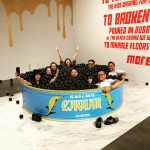The Foodie Space caters toward food pho-natics and even lets viewers play with their food.
The interactive art exhibit, opening Thursday using the building of the now closed Pasadena Museum of California Art, brings fine art to an unexpected audience: the foodie Instagrammers who have no problem holding up a hungry crowd for the perfect picture. From massive takeout boxes to a chapel dedicated to french fries, the exhibit features whimsical, interactive elements and murals to immerse viewers in food. Initially inspired by her own obsession with food photography, co-founder Ugne Ragauskaite said the exhibit was transformed from a more lighthearted, solely commercial-based vision to bringing to life the artists’ personal stories involving food.
“We have a mix of this fun commercial stuff like caviar pools, but then we also have fine art as well,” Ragauskaite said. “It could attract people that wouldn’t really go to museum shows, so that they would come in for a more fun purpose, but then they would come out seeing some fine art and maybe would like to come to other more traditional museums in the future.”
Contributing artist Trinh Mai’s portion of the exhibit will feature a pho-themed room, entitled “All Phở the Love,” with noodles hanging from the ceiling. As a Vietnamese-American, Mai, who took an advanced painting class at UCLA, said pho was a staple meal in her household and her family’s recipe has been handed down from generation to generation, incorporating minor tweaks with each passing. Although her family is not always verbally affectionate, Mai said her parents and relatives show their love through the making and sharing of food.
Mai’s interactive room will feature Sriracha bottles and fabricated pho ingredients, including anise seeds and onions, allowing viewers to create their own pho recipe. Mai said she was inspired by her family recipe being passed down from mother to daughter as a way of caring for future generations, paralleling her grandparents’ emigration from Vietnam.
“It’s like passing on this love for a generation that doesn’t even exist yet, which is also very related to (my grandparents’) escape from the war,” Mai said. “They knew death was a possibility but they decided to escape anyway, knowing that they might die because it was worth it for them. … They knew if they made it, my generation would have freedom.”
In the second portion of her exhibit, Mai created a tea room, inspired by chats over tea with her grandmother. Mai made oversized tea bags out of agricultural netting. Pressed eucalyptus and bay leaves fill the bag, and viewers can actually smell the art.
While viewers can tickle their olfactory senses in Mai’s exhibit, they can hug and marry french fries in Julia Taft’s installation. Taft, another featured artist in the exhibit, used her installations to explore her own journey with self-care after recovering from an eating disorder. Taft created a pink wedding chapel with pews and an altar with giant french fries waiting at the end of the aisle. Taft said the concept of her exhibit, entitled “Fries Before Guys,” was influenced by her personal experience with a toxic relationship that aggravated her eating disorder. Now recovered, Taft said she orders fries and a milkshake on first dates as a reminder to put her happiness first.
“By restricting or crazy dieting … or trying to always be thinner or more of this and less of me, it felt like I would lose a little bit of myself in that process,” Taft said. “(I created) pretty fun pieces but it took a lot of work to try and make them fun.”
Demonstrating her decision to eat foods she loved instead of forcing herself to eat low-calorie yogurts or sugar-free Jell-O, Taft created an exhibit in which the viewers can marry their food, symbolizing her choice to make her relationship with food a more amicable one. Taft said she felt forced to conform to perceived societal beauty standards, but has used this exhibit to share how she has shifted her mindset to put herself first while maintaining a quirky, lighthearted atmosphere.
“As serious as a subject as it is, if you just leave people with a negative connotation, then there’s no real hope of how to move forward from (it),” Taft said. “It’s a dark subject for me to talk about, but I think it’s good to spread light upon it and have fun with it, so why not jump on a big pizza?”
Although the exhibit at its core is eccentric, Mai said the beauty of the each artist’s work lies in its expression of their personal experiences. Viewers can connect to the art work beyond its surface-level expression because of the emotional stories the artists have invested in them.
“We’re not just creating stuff for people to take photos with, we’re really creating environments that really speak to what we’ve experienced and our histories,” Mai said.
